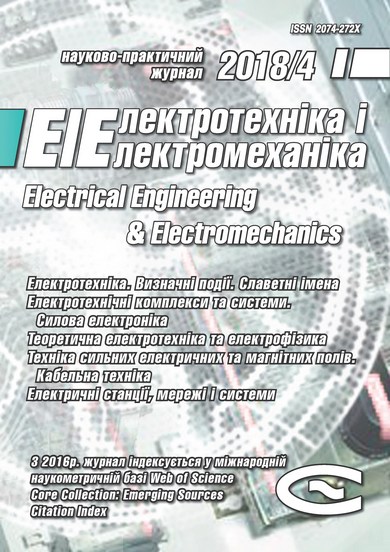STABILITY AND ACCURACY OF THE ROBUST SYSTEM FOR STABILIZING THE ROTOR FLUX-LINKAGE OF AN ASYNCHRONOUS ELECTRIC DRIVE AT RANDOM VARIATIONS OF THE UNCERTAIN PARAMETERS WITHIN THE SPECIFIED BOUNDARIES
DOI:
https://doi.org/10.20998/2074-272X.2018.4.06Keywords:
electric drive, vector control, flux-linkage channel, stabilizing robust system, stability, accuracyAbstract
Purpose. The aim is to investigate the stability and the accuracy of a robust system for stabilizing the rotor flux-linkage of an asynchronous electric drive at random variations of the uncertain parameters of the object and the regulator within the specified boundaries. Methodology. To make the research, the mathematical model of the rotor flux-linkage channel of the vector control system of an asynchronous electric drive with parametric uncertainty was applied. The transfer function of the Н∞-suboptimal regulator was calculated using the mixed sensitivity method. This transfer function was used to construct the regulator structural scheme in the form of a connection of proportional and integrating links and several adders. Analytical dependences of the coefficients of the regulator's transfer function on the parameters of links of such a connection are determined. These dependences served to researching the influence of uncertain parameters of the regulator links and the object on the stability of the robust system and the accuracy of flux-linkage stabilization. Results. Investigations of the robust system stability and the accuracy of flux-linkage stabilization in the Robust Control Toolbox are done. The curves of the flux-linkage transient processes and the Bode diagram for the open system at random variations of the indeterminate parameters of the object and the regulator links within the specified boundaries are constructed. A choice of variable parameters was carried out by the Monte Carlo method. By the scatter of the obtained curves of the transient processes, the accuracy of flux-linkage stabilization was determined, and according to the Bode diagram, stability reserves in the amplitude and the phase of the robust system were determined. A high accuracy of flux-linkage stabilization (deviation less than 1 %) in fairly wide ranges of changing the uncertain parameters of the object and the regulator, while maintaining the stability of the system with permissible reserves in amplitude and phase, is established. Originality. For the first time, analytical dependences of the coefficients of the transfer function of the Н∞-suboptimal regulator on the parameters of its structural scheme, which represented in the form of a connection of proportional and integrating links, are obtained. The method for calculating the stability of a robust flux-linkage control system and the accuracy of its stabilization at random variations of the uncertain parameters of the object and the regulator links within the specified boundaries is developed. Practical value. The use of the proposed method allows, during the design of the regulator, to ensure the selection of its elements from standard series.References
1. Khlopenko N.J., Khlopenko I.N. Structural synthesis of a stabilizing robust controller of the rotor flux linkage. Electrical engineering & electromechanics, 2017, no.1, pp. 21-25. (Rus). doi: 10.20998/2074-272X.2017.1.04.
2. Elistratov V.D., Ilina A.G. Robust control by servo drive with non-rigid load with H-infinity norm limitation. Vestnik of Astrakhan State Technical University. Series: Marine Engineering and Technologies, 2016, no.4, pp. 89-94. (Rus).
3. Kuznetsov B.I., Nikitina T.B., Kolomiets V.V., Khomenko V.V. Investigation of the effect of nonlinearities and variations of the control object parameters on dynamic characteristics of the electromechanical servo systems. Bulletin of NTU «KhPІ», 2015, no.12(1121), pp. 68-71. (Rus).
4. Nesenchuk A.A., Opeiko O.F., Odnolko D.S. Dynamics simulation and calculation of robust parameters for the electric drive control system on the basis of the root locus portraits. Artificial Intelligence, 2014, no.3, pp. 90-103. (Rus).
5. Nikitina T.B. Pareto optimal solution of multiobjective synthesis of robust controllers of multimass electromechanical systems based on multiswarm stochastic multiagent optimization. Electrical engineering & electromechanics, 2017, no.2, pp. 34-38. doi: 10.20998/2074-272X.2017.2.05.
6. Peresada S.M., Kovbasa S.N., Bovkunovich V.S. Rough vector control torque and flux induction motor. Technical electrodynamics, 2010, no.1. pp. 60-66. (Ukr).
7. Potapenko E.M., Kazurova A.E., Savranskaya A.V. Review of works on dynamics of multimass uncertain electromechanical systems carried out in ZNTU electric drive department. Electrical Engineering and Power Engineering, 2011, no.1, pp. 7-10. (Rus). doi: 10.15588/1607-6761-2011-1-1.
8. Ostroverkhov M.J., Pyzhov V.M. Robust speed vector control system of gated inductor type electrical drive. Electromechanical and energy saving systems, 2015, iss.3/2015(31), pp. 32-38. (Ukr).
9. Rudnev E.S., Morozova D.I. µ-synthesis of robust speed controller of synchronous electric drives. Electrotechnic and computer systems, 2015, no.20, pp. 42-50. (Rus). doi: 10.15276/eltecs.20.96.2015.06.
10. Richard Y., Chiang R., Michael G., Safonov M. MATLAB: Robust Control Toolbox. User’s Guide. Version 2, 1998. 230 p. Available at: http://www.mathworks.com (Accessed 12 May 2016).
Downloads
Published
How to Cite
Issue
Section
License
Copyright (c) 2018 I. N. Khlopenko, S. A. Rozhkov, N. J. Khlopenko

This work is licensed under a Creative Commons Attribution-NonCommercial 4.0 International License.
Authors who publish with this journal agree to the following terms:
1. Authors retain copyright and grant the journal right of first publication with the work simultaneously licensed under a Creative Commons Attribution License that allows others to share the work with an acknowledgement of the work's authorship and initial publication in this journal.
2. Authors are able to enter into separate, additional contractual arrangements for the non-exclusive distribution of the journal's published version of the work (e.g., post it to an institutional repository or publish it in a book), with an acknowledgement of its initial publication in this journal.
3. Authors are permitted and encouraged to post their work online (e.g., in institutional repositories or on their website) prior to and during the submission process, as it can lead to productive exchanges, as well as earlier and greater citation of published work.





